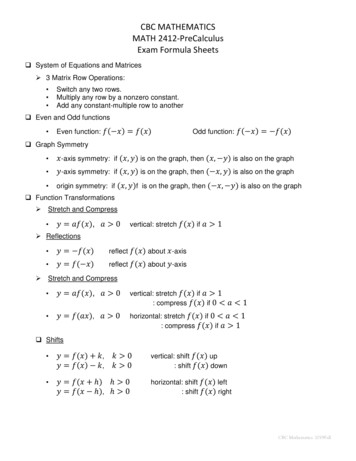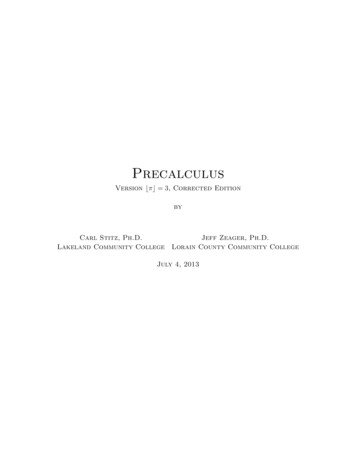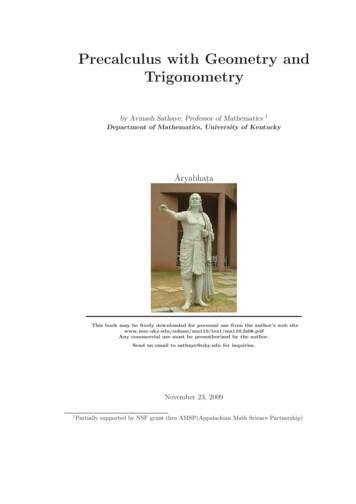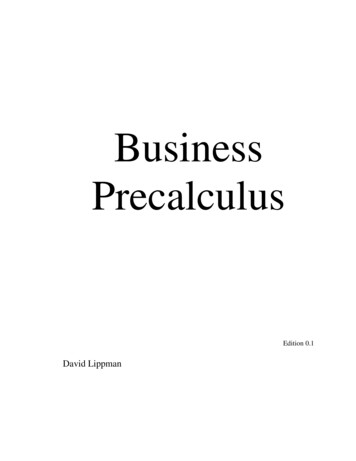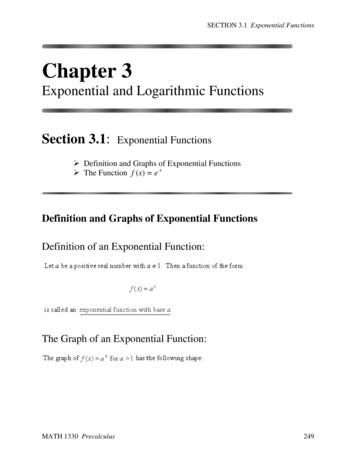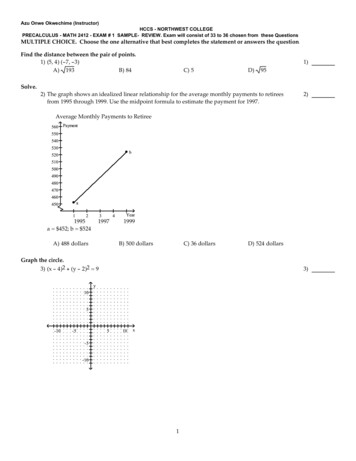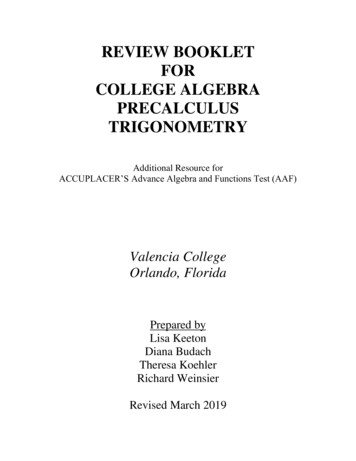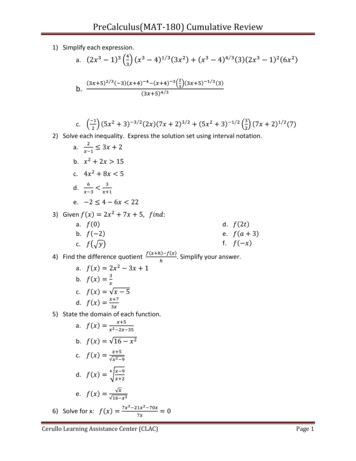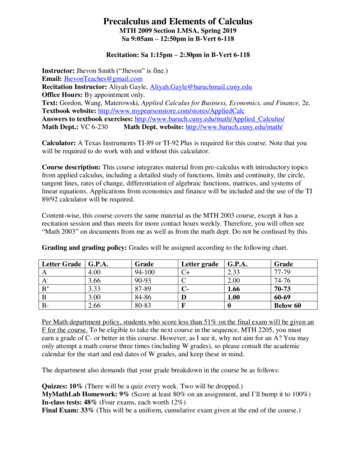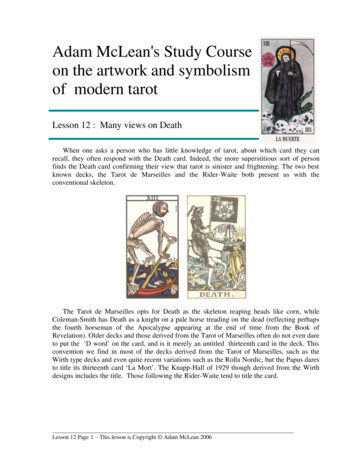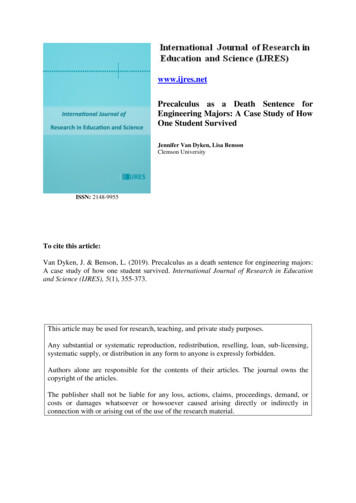
Transcription
www.ijres.netPrecalculus as a Death Sentence forEngineering Majors: A Case Study of HowOne Student SurvivedJennifer Van Dyken, Lisa BensonClemson UniversityISSN: 2148-9955To cite this article:Van Dyken, J. & Benson, L. (2019). Precalculus as a death sentence for engineering majors:A case study of how one student survived. International Journal of Research in Educationand Science (IJRES), 5(1), 355-373.This article may be used for research, teaching, and private study purposes.Any substantial or systematic reproduction, redistribution, reselling, loan, sub-licensing,systematic supply, or distribution in any form to anyone is expressly forbidden.Authors alone are responsible for the contents of their articles. The journal owns thecopyright of the articles.The publisher shall not be liable for any loss, actions, claims, proceedings, demand, orcosts or damages whatsoever or howsoever caused arising directly or indirectly inconnection with or arising out of the use of the research material.
International Journal of Research in Education and ScienceVolume 5, Issue 1, Winter 2019ISSN: 2148-9955Precalculus as a Death Sentence for Engineering Majors: A Case Study ofHow One Student SurvivedJennifer Van Dyken, Lisa BensonArticle InfoAbstractArticle HistoryFew college students wanting to major in an engineering discipline who beginin precalculus actually complete an undergraduate engineering degreeprogram. One reason for this is students struggle through calculus I and II,known barrier courses for engineering majors. This research utilizesframeworks of future time perspective (FTP) and self-regulated learning(SRL) to explore one successful student‟s experience as he struggled throughhis mathematics courses, but was able to overcome those struggles andgraduate with an engineering degree. A case study was constructed aroundthis student, using quantitative data from his mathematics and engineeringcourses, as well as qualitative data in the form of an open-ended survey andinterviews. A mathematics instructor, who modeled self-regulation strategiesas he served as the student‟s mentor, was key to his success in passing therequired courses in the calculus sequence. A model of interactions betweenFTP and SRL was developed based on an existing model and insights fromthis case study. By understanding the experience of one of the few successfulstudents, educators are better equipped to assist other students and increase thenumber of students persisting in engineering, which will help address theglobal need for more engineers.Received:14 June 2018Accepted:08 December 2018KeywordsPrecalculusCalculusEngineeringCase studyIntroductionAttrition in engineering education is a well documented problem, with 40 – 60 % of students who entered auniversity as an engineering major choosing to change majors or to leave the university (Budny, LeBold, &Bjedov, 1998; Geisinger & Raman, 2013; Moses et al., 2011; Ohland et al., 2008; Seymour & Hewitt, 1997).Calculus I and II are known barrier courses for engineering majors (Suresh, 2007). Performance in these barriercourses, as well as the interest and motivation to succeed in engineering, affect a student‟s persistence in anengineering program (Levin & Wyckoff, 1995; Suresh, 2007). Mathematics ability in general has beenidentified as the best single predictor of success in engineering (Levin & Wyckoff, 1988). Mathematics isconsidered a key to thinking like an engineer (Godfrey & Parker, 2010). By understanding the difficultiesstudents face in mathematics courses, ways to help students overcome those struggles and be successful in theirpursuit of engineering degrees can be identified.Our university is located in the Southeastern United States, in a suburban setting. Roughly 26% of the newstudents enrolled each year declare an engineering major. At our university, historical data shows that studentswho declare an engineering major and take precalculus as their first math course are unlikely to complete anengineering degree program. Table 1 shows the number of engineering students matriculating between Fall2006 and Fall 2010 (5 years) by initial mathematics course, the number of those who graduated in any majorand those who graduated in engineering. The last column shows the percent of engineering students whograduated in an engineering discipline. Of those in this study, only 795 (20.41%) are female, and 3286 (84.34%)identified as Caucasian.For our five years of data on graduation rates by mathematics course, over 80% of engineering students startingin precalculus either changed majors, left the university, or did not complete the engineering program within sixyears, compared to less than 40% in each of the other calculus courses, I – III. Many of the students who beganin precalculus left the university or changed majors within their first year (Authors, 2015). The graduation rateswere found to be significantly different for the five initial mathematics courses based on the Chi-square test (p 0.001). The percentage of students starting in precalculus who graduated within six years was significantlylower than those starting in “Long Calculus” (precalculus review and calculus I stretched over two semesters)
356Van Dyken & Bensonor one of the calculus courses (I-III). In fact, an engineering student starting in Calculus I is almost 3.5(65.41/19.08 3.43) times more likely to graduate with an engineering degree than one starting in precalculus.Table 1. Six year graduation rates of students majoring in engineering by initial math course, 2006 – 2010PercentGraduated fromGraduated inCourseEnrollmentGraduated 3319.08Long Calculus69548228140.43Calculus I17721460115965.41Calculus II61950642468.50Calculus III63756050078.49Total38963092239761.52Note. “Long Calculus” is calculus I stretched out over two semesters, with roughly a third of the first semesterdedicated to reviewing precalculus material.In addition, Figure 1 shows the percentage of students starting in a specific mathematics course between Fall2006 and Fall 2010 who graduated in each of the engineering disciplines offered at our university. The overalldistribution is included at the end as a baseline. From this graph, we can see the majority of graduatingengineers began in one of the calculus sequence courses. However, there are engineering disciplines with higherthan average percentages of students starting in precalculus, like electrical, environmental, and industrial.Figure 1. Percentage of engineering graduates starting in different mathematics courses by major, 2006 – 2010This research seeks to understand the factors that contribute to students‟ persistence in engineering when theybegan their studies in precalculus, a pre-college level mathematics course and struggled with their mathematicscourses. Many of the students who remain in the program repeat one or more mathematics courses. The fact thatso few are able to succeed in engineering programs after starting in precalculus begs the question: What is itabout those students who do make it, and what about their experience might help future students stay on track?To begin to answer this question, a single case study was conducted on an engineering student who started inprecalculus and struggled throughout his mathematics courses. This case study will answer the followingquestions pertaining to the student‟s completion of required mathematics courses:1. In what ways did the student struggle in his required mathematics courses?2. How did the student get through the required courses and stay on track for his degree program?
Int J Res Educ Sci357An additional research objective was to develop a theoretical model by which researchers can study similarcases in science, technology, engineering, and mathematics (STEM) education.Theoretical FrameworksFuture Time PerspectiveFuture time perspective (FTP) examines how students‟ future goals affect actions they take in the present andwhat, if any, subgoals or contingent steps they recognize as being necessary to get there (De Volder & Lens,1982; Husman & Lens, 1999; Miller, DeBacker, & Greene, 1999). With a contingent path, one cannot proceedto the next step without successfully completing the previous step (Husman & Lens, 1999; Raynor, 1981). Forexample, a student cannot take calculus II until successfully completing calculus I. Students with long-termgoals better understand consequences of current class activities on their future goals. Because of this, they areable to plan ahead, create subgoals and find ways to make progress along their contingent path (Husman &Lens, 1999; Husman & Shell, 2008; Miller et al., 1999). Perceived instrumentality is the extent to which onesees the current task as being important to reaching one‟s future goal (Husman & Lens, 1999; Miller &Brickman, 2004; Miller et al., 1999). Instrumentality can be endogenous (the task is central to their future goal)or exogenous (the task is seen as merely a requirement to move to the next task, having no other value for theirfuture goal) (Husman, 1998). Students‟ perceptions of instrumentality of their course work to their future goalshave been found to be positively correlated with self-regulation and persistence (Miller, Greene, Montalvo,Ravindran, & Nichols, 1996). For students with required courses as “steps” in their path to their future goals,failure in the course will require them to repeat the “step,” which increases the distance to their future goal.Personally valued future goals are set by the student, and commitment to these goals sets the stage for thedevelopment of proximal subgoals used to reach their future goals (Miller & Brickman, 2004; Nuttin, Lorion, &Dumas, 1984). As the path of subgoals becomes more concrete and the student moves further along the path,they become more committed to their future goal (Markus & Ruvolo, 1989). The higher their self-efficacy foraccomplishing their future goal (the more they believe they can attain it), the more effort they will put towardreaching it (Bandura, 1989). Once realistic proximal subgoals have been set, self-regulated learning in the formof self-observation, self-evaluation, and self-reaction play a role in completing these subgoals (Bandura, 1986;Miller & Brickman, 2004; Schunk, 1990).Self-Regulated LearningSelf-Regulated Learning (SRL) has been defined as “an active, constructive process whereby learners set goalsfor their learning and attempt to monitor, regulate, and control their cognition, motivation, and behavior, guidedand constrained by their contextual features in the environment” (Pintrich, 2005, p.453). Self-regulated studentsuse cognitive learning strategies (rehearsal, elaboration, organization) and metacognitive strategies (planning,monitoring, regulating) to understand course material and complete tasks (Garcia & Pintrich, 1994; Pintrich,1999, 2004; Pintrich & De Groot, 1990; Zimmerman, 1986). Self-regulated students also manage and controlefforts on tasks by managing their time, adjusting their study environment as necessary, and seeking assistancewhen needed (Garcia & Pintrich, 1994; Karabenick & Knapp, 1991; Pintrich, 1999, 2004; Pintrich & De Groot,1990; Zimmerman, 1986).Zimmerman and Martinez-Pons developed a framework with 14 self-regulated learning categories: selfevaluation, organizing and transforming, goal-setting and planning, seeking information, keeping records andmonitoring, environmental structuring, self-consequences, rehearsing and memorizing, seeking social assistancefrom peers, teachers or adults, and reviewing tests, notes or textbooks (Zimmerman & Martinez-Pons, 1986).Studies have shown the use of self-regulation strategies improves academic performance (Bandura & Schunk,1981; Kitsantas, Winsler, & Huie, 2008; Pintrich, 1999; Pintrich & De Groot, 1990; Zimmerman, 2008). Selfregulated students seek out information and assistance when they need help (Zimmerman & Martinez-Pons,1988). Instructors can encourage students to ask for help by showing them the intrinsic value in learning andputting them in group situations where they can help peers (Newman, 2002).Self-regulation is a choice made by students who are motivated to learn (Boekaerts, 1999; Pintrich, 2004;Zimmerman, 1994). In fact, “positive self-perceptions are assumed to be the motivational basis for selfregulation during learning” (Zimmerman & Martinez-Pons, 1986, p. 308). Students who are interested in thematerial, believe it is important, and believe they are capable of successfully completing the task are more likely
358Van Dyken & Bensonto use learning strategies and be successful (Bandura & Schunk, 1981; Pintrich, 1999; Pintrich & De Groot,1990; Zimmerman, 1986, 2005). Tabachnick, Miller, & Relyea, (2008). discussed how students starting inremedial courses, such as precalculus, have typically weaker self-regulation strategies, such as study skills, andthat goals, both future and proximal, predicted self-regulation strategies. Students with poor or no selfregulation strategies have been defined as having maladaptive learning profiles (Nelson, Shell, Husman,Fishman, & Soh, 2015; Shell & Husman, 2008). Engineering students have been found to develop thesemaladaptive learning profiles while taking required foundational courses outside of engineering, like calculus(Nelson et al., 2015). These students either did not use any self-regulation strategies, were unsuccessful duringself-regulation, or were not engaged enough during self-regulation to retain knowledge (Nelson et al., 2015;Shell & Husman, 2008).A Model Connecting FTP and SRLGoal-setting, a common strategy during self-regulation, is a key link between future time perspective and selfregulation (Bandura & Schunk, 1981; Zimmerman & Martinez-Pons, 1986). Miller and Brickman developed amodel of future-oriented motivation and self-regulation that combines theories of future time perspective andself-regulated learning (Miller & Brickman, 2004). Their model proposes that one‟s future goals influence selfregulation in the present and encourage one to create proximal subgoals, which act as stepping stones on thepath to their future goal. Once these subgoals are set, self-regulation is triggered to help set and accomplishtasks within each of the proximal subgoals. Those who see the tasks and proximal subgoals as beinginstrumental in reaching their future goals are able to see the value in completing the subgoals (Miller et al.,1999). If students are able to connect their current tasks to future goals, they will perceive having more controlin navigating their path to their future (Husman & Lens, 1999; Husman & Shell, 2008). The Miller andBrickman model served as a basis for the model that we sought to develop for our case study, one that helpsexplain our case study and generalize results beyond our single case.MethodParticipant SelectionThe population from which the case study participant was selected is students who entered the universitycommitted to majoring in engineering, but who lacked the mathematical background to begin in a college levelmathematics course. One of the cohorts from the Table 1 data had thirty-one such students who began inprecalculus, the lowest level mathematics course in which an engineering major can begin. Of those, only sevenstudents were either able to complete the curriculum or were still progressing and on track to graduate within sixyears when our study began. This particular cohort was chosen because we wanted to be able to interview theparticipant(s) as close to their graduation date as possible, and all were within six years from universitymatriculation. It was concluded two of the seven did not struggle in mathematics, based on their consistentlyhigh grades in subsequent mathematics courses and the fact that they did not have to repeat any mathematicscourses. They likely should not have been placed in precalculus in the first place, and while they were includedin the Table 1 data, they were not considered for this case study, since we were looking specifically for studentswho had difficulties in mathematics. The case study student, “Nick” (all names are pseudonyms), was selectedout of the remaining five students because he fit our criteria and responded to our email invitation to participatein the study. Nick started in precalculus with engineering as his declared major, struggled in his mathematicscourses (failed and repeated calculus II multiple times), but made it through an engineering curriculum andgraduated with a degree in industrial engineering five years after matriculating.Data CollectionCase studies serve to get at the depth of a phenomenon (Eisenhardt, 1989; Flyvbjerg, 2011; George & Bennett,2005; Stevenson, 2004). It is of interest to understand the experience of our case study participant in hismathematics courses and his difficulties in mathematics. To fully answer the research questions about thestudent‟s experience, our case study is bounded by his engineering education experience, including any priorexperiences that influenced or motivated him to major in engineering, his academic preparation prior to college,the advising he received while in college, and his experience during his mathematics-based courses.
Int J Res Educ Sci359Nick was first asked to complete an open-ended survey based on engineering and math identity. The surveyasked questions such as, “Do you see yourself as an engineer/math person?” and asked him to describe a time hewas recognized as an engineer/mathematician. It also asked what he wanted to do for a career and who (or what)was most influential to his career choice. Many of the open-ended survey questions were adapted from a studywhich looked at engineering identity and students‟ sense of belonging in engineering (Godwin & Potvin, 2015).The survey was modified by removing the questions that focused on physics identity and adding questionswhich asked about mathematics courses taken at the university, which ones were difficult, why the studentfound them difficult, and how the student overcame challenges.The results from the open-ended survey were used to create the interview protocol for the first interview withNick. The goal was to further understand why he chose engineering as a major, why he did not quit or changemajors when he was struggling with math, and who helped or encouraged him the most during his collegeexperience. During his first interview (80 minutes), Nick identified his mother, one of his advisors, and aninstructor in the Mathematical Sciences Department who served as a mentor over multiple semesters as beinginstrumental in his success and persistence in engineering. These three individuals were interviewed (15 minuteseach), which provided the opportunity to strengthen the case study by validating what Nick said in his interview(Yin, 1984). These interviews were followed by a second interview with Nick (50 minutes) to further clarify hismathematics background (high school), the consequences of starting in a non-college level mathematics course,and what the result would have been had he changed majors to something other than an engineering discipline.The survey was completed and all interviews were conducted during his final semester at the university.Upon selecting this student and receiving IRB approval to collect all quantitative performance data for our casestudy, we realized from his transcript that he was in a section of the first year engineering course that wasincluded in a separate study of engineering students‟ problem solving skills (NSF award number EEC –1048325, “CU Thinking”), taught by the second author. As a result, we also collected examples of his coursework, as well as exam grades from that course. A subset of this quantitative data (math placement testinformation, transcript grades, and first year engineering coursework) was used in this case study to strengthenand verify our results from the interviews (Creswell, 1998; Eisenhardt, 1989; Flyvbjerg, 2011; Perry, 1998; Yin,1984). This rich data set allows for an in-depth case study and triangulation of data from multiple sources(Eisenhardt, 1989; Flyvbjerg, 2011; Yin, 1984).Researcher’s PerspectiveThe primary author is faculty in the Mathematical Sciences Department. During her years of teaching, she hastaught many mathematics courses, including Long Calculus. She observed that many students in Long Calculushad a difficult time with the precalculus review material. Typically, these students came into the university withpoor algebra skills. Because the main author has taught this course multiple times and has seen many studentswith the same problem, when the case study student was selected, it was suspected that he too came in with pooralgebra skills, especially because he started in precalculus, an even lower level course than Long Calculus.The lead author is also the registration coordinator for the Mathematical Sciences Department. Through her jobexperiences, she has seen the poor retention rates for engineering students starting in precalculus and LongCalculus. Some students who leave engineering for a major requiring different math courses say they leavebecause engineering was not what they thought it was. Others leave because they think engineering will be toodifficult. But many cite that the math is too difficult. With so few students staying in the program who start inprecalculus and Long Calculus, it was important to this author to identify what the faculty and advisors couldhave done to help motivate or better prepare the students who chose to give up on engineering because ofdifficulties in the required mathematics courses.Data AnalysisApplying Theoretical Frameworks for Interpreting Nick’s ExperienceBecause Miller and Brickman‟s theory (2004), which integrates future time perspective and self-regulatedlearning, was an appropriate model to begin mapping Nick‟s experience, Nick was asked to describe how heovercame his mathematical challenges and created stepping-stones on his path to his career goal. Nick had aclearly defined future goal, a distinct subgoal of graduating with an engineering degree, and within that subgoalwere even more subgoals, one of which was to pass the required mathematics courses. Prior knowledge, future
360Van Dyken & Bensongoals, and the creation of subgoals, or a contingent path, follow the future-oriented part of the Miller andBrickman model. The process by which he was able to motivate himself and work through the barriers he facedwhile progressing through the engineering program are supported and explained by the proximal self-regulationhalf of the Miller and Brickman model.Proximal self-regulation refers to the process by which students selfregulate while working through their proximal goals.Coding and Interpretation of DataDeductive coding (Onwuegbuzie & Combs, 2010) was used when analyzing the interview transcripts, where theelements within Miller and Brickman‟s model (2004) served as the pre-determined codes. Transcripts wereanalyzed using RQDA, an R package used to code qualitative data (Huang, 2016). Internal validity wasestablished using pattern matching, which compares and matches data from multiple sources (Eisenhardt, 1989;Saldaña, 2011; Yin, 1984). When patterns were found that didn‟t correspond with an element in Miller andBrickman‟s model, a new code was created using emergent coding. Once all patterns relevant to Nick‟sengineering education experience were identified, the transcripts were examined again to identify all possibleconnections between the codes. Several iterations were conducted before finalizing the mapping of Nick‟s storyto the new model.The open-ended survey responses and interview data that had been coded as „Proximal Task Engagement andSelf-Regulation‟, an item within Miller and Brickman‟s (2004) model representing the strategies used andcommitments made by a student while working on their current subgoal, were then subcoded in RQDA, thistime using a codebook established from Zimmerman and Martinez-Pons‟ 14 self-regulation strategies (Chasmar,Melloy, & Benson, 2015; Zimmerman, 1986). Seeking social assistance from peers, teachers, or adults wereconsolidated to a single category, seeking social assistance, also referred to as help seeking (Garcia & Pintrich,1994; Karabenick & Knapp, 1991; Newman, 1994; Pintrich, 1999). Likewise, activities related to reviewingrecords from tests, notes, or textbooks were consolidated to a single code, reviewing records. Pattern matchingwas again used to compare codes between the different data sources (Eisenhardt, 1989; Saldaña, 2011; Yin,1984).Quality ConsiderationsSeveral techniques were used to ensure that quality was maintained when making inferences from the data.First, sufficient time was spent with Nick during his final semester to build a relationship and get a goodunderstanding of his story from his own perspective (Creswell, 1998; Onwuegbuzie & Leech, 2006). Nickopened up quickly and wasn‟t shy about elaborating when asked questions about his experience. Second, byutilizing multiple sources of data, the findings could be triangulated (Creswell, 1998; Eisenhardt, 1989; Miles &Huberman, 1984; Onwuegbuzie & Leech, 2006; Stake, 1994; Yin, 1984). Interviews with his mother, advisor,and instructor, along with his academic transcript, confirmed his self-reported journey. Throughout the researchproject, meticulous notes were taken so an outside researcher could follow the process (Eisenhardt, 1989;Onwuegbuzie & Leech, 2006; Yin, 1984). Lastly, this manuscript was shared with the participants (Creswell,1998; Miles & Huberman, 1984; Yin, 1984). No corrections were necessary, but participants provided moredetails for clarification.Results and DiscussionOverview of Nick: Past Experiences and ValuesNick was raised in a large city on the Southeastern coast of The United States. At the age of 10, Nick‟s fatherbecame ill and passed away. Nick and his mother developed a very close bond. Throughout his youth Nickparticipated in sports and church activities. He formed a bond with many of the coaches and church members.His devotion to his religion continued into college when he helped start a Christian fraternity on campus. As anathlete in grade school, he quickly developed into a leader for the younger athletes and understood thecorresponding responsibility. Nick enjoyed his leadership role and wanted to be recognized as a leader in futureendeavors.
Int J Res Educ Sci361If I wanted the younger kids to be doing good in school, then I needed to be doing good in school [Itwas] me showing value in the grades at the same time and showing that basketball and football are aprivilege after you perform in the classroom. (Nick)Nick is Caucasian, and at the time of our initial interview, was 22 years old.Nick’s Future: Interest, Future Goal and System of Proximal SubgoalsNick attended a very small, private, Christian school with grades kindergarten through 12th. Because it was anew school, the administration relied on teachers to establish the curriculum. After completing an assignment inhistory class on World War I ace Eddie Rickenbacker, his teacher (the wife of one of the male leaders in hischurch, who had also served in the Unites States Air Force) asked Nick if he had considered going into the AirForce. At the time he hadn‟t considered it, but he soon decided he wanted to be an Air Force pilot (Future Goal).He was not accepted into the United States Air Force Academy after graduating from high school, so he decidedto attend college elsewhere. It was important to Nick to find a way to pay for college. “I always wanted to getschool paid for so mom didn‟t have to worry about that.” So he pursued a scholarship through the ReserveOfficers‟ Training Corps (ROTC). He filled out the ROTC scholarship application indicating he would major inan engineering discipline (Subgoal), something he knew the Air Force was looking for (which was confirmed byhis ROTC advisor), and was given a full scholarship and five years to complete an engineering degree programat a southeastern land grant institution.Luke was one of Nick‟s ROTC advisors at the university and had served in the military for more than 25 years.As Nick‟s advisor, he was charged with helping Nick map out his degree program and stay on track so he couldgraduate on time. Luke advised roughly 50 students each semester. As an engineering major, Nick was requiredto take calculus I - III. These math courses serve as proximal subgoals and contingent steps necessary for theengineering degree. Proximal subgoals here are similar to what Miller and Brickman (2004) refer to as proximaltarget goals in their model. Nick understood the importance of these math courses for his engineering degree(Perceived Instrumentality). Nick saw the required calculus courses as having exogenous instrumentality(Husman, 1998) for his future goal, because he did not believe that he would use calculus as an Air Force pilot,but if he couldn‟t complete the required mathematics courses, he wouldn‟t graduate with the engineering degreehe deemed necessary to be an Air Force pilot.Luke started in a common first year engineering program, which was required of all engineering majors at hisuniversity. Students cannot matriculate into an engineering major until they have completed certain courses,including calculus I and II. Through the open-ended survey, Nick revealed he originally wanted to go intomechanical engineering, but when Luke realized mathematics was not one of Nick‟s strengths, he encouragedNick to major in industrial engineering instead, which only requires calculus I - III, while mechanicalengineering requires three additional mathematics courses, all with calculus III as a prerequisite. Even Nickrecognized the importance of strong math skills for mechanical engineering: “I was originally thinkingmechanical engineering, but I was struggling with math early.” Luke‟s
in precalculus actually complete an undergraduate engineering degree program. One reason for this is students struggle through calculus I and II, known barrier courses for engineering majors. This research utilizes frameworks of future time persp
